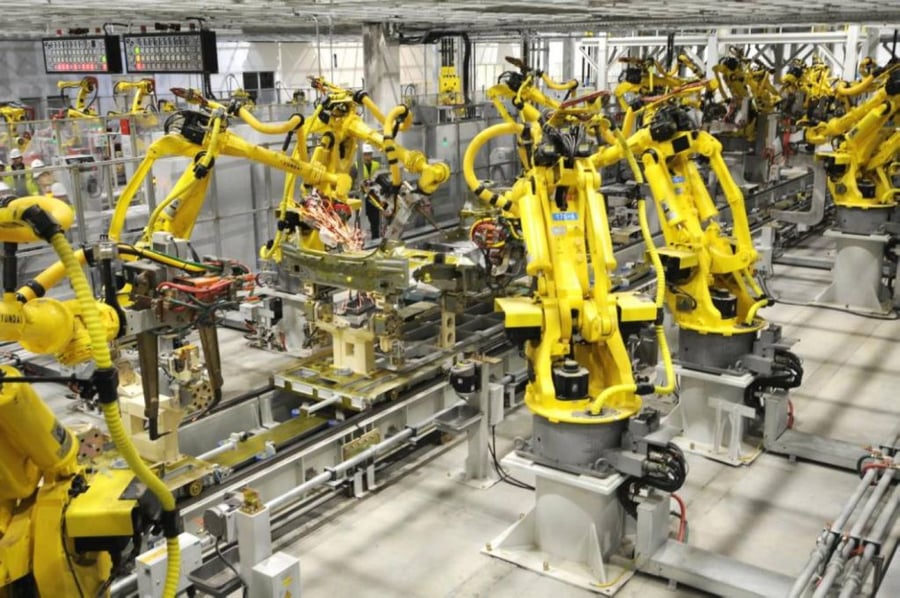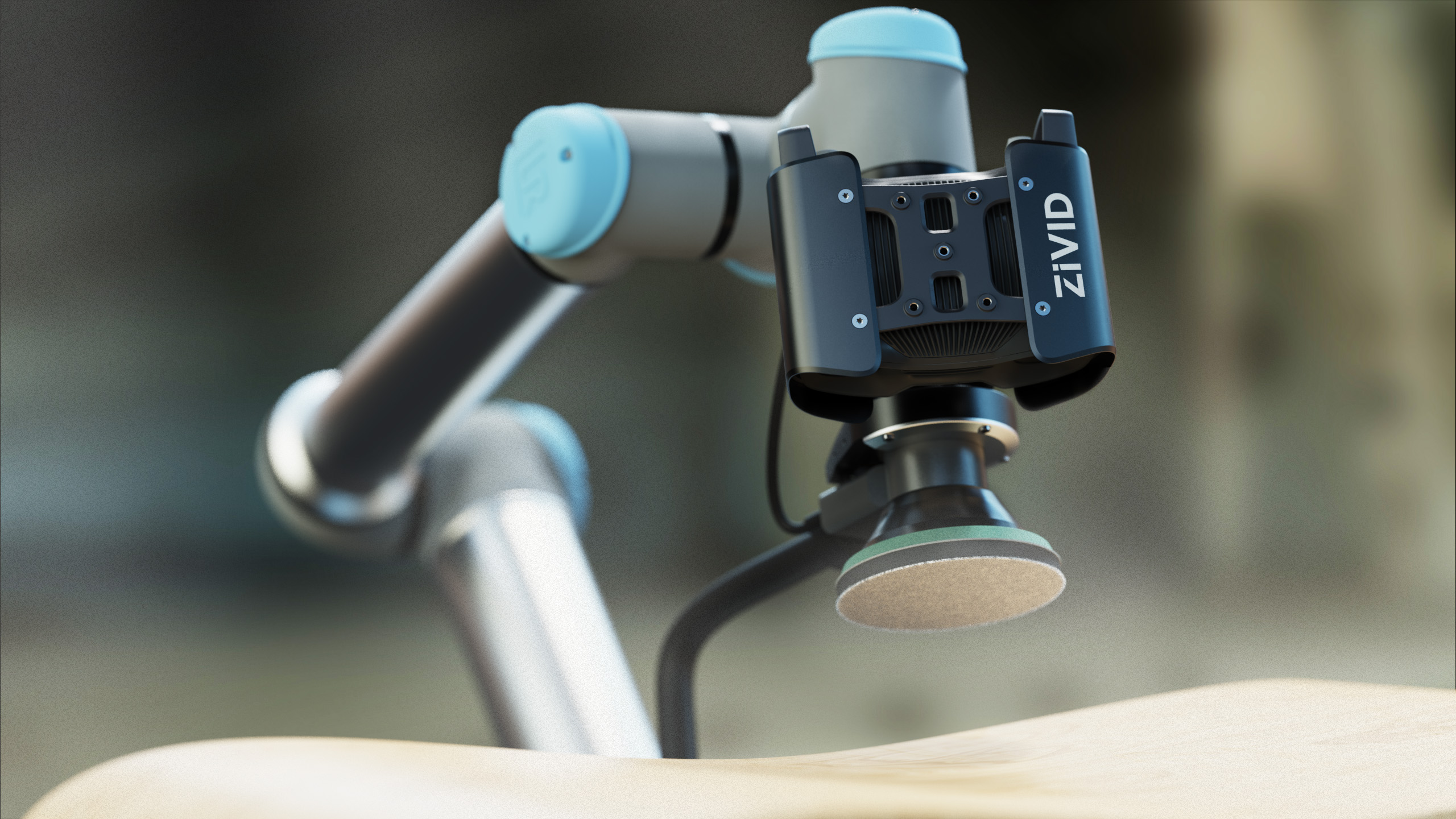Company
Pickit 3D Korea
Application
Automotive
Surface finishing
Robot guidance
Smart factory
Robotic sanding
Features
Robot-mounted 3D vision for robotics
3D color (RGB)
M-HD2 automation software
3D camera
Zivid 2 industrial 3D color camera
Published
22 Aug 2022
Dust spots on a car’s bodywork are a big challenge in automotive surface finishing processes. It is tiring and repetitive work for humans to conduct and requires a great deal of concentration to catch all dust spots. Usually, a team of four or more people is needed for each car in this process. The dust spots are usually very small in size, and automating this process requires that the absolute position of the dust spot and the vehicle’s position is known, in addition to the dust spots profile for effective removal.
Robot-mounted Zivid 2 3D industrial cameras were used in the solution. The high performance and industrial grade of Zivid 2 meant very accurate 3D positional information could be used to synchronize the robots with the position of the vehicle. It also gives exactly accurate profile data so that the sanding is carried out to the degree necessary.
PickIt were able to deliver a world-first automation solution for this challenge to Hyundai in Korea. The solution uses 3D imaging with PickIt’s new M-HD2 automation software, and the Zivid 2 robot-mounted industrial 3D camera. It was a requirement to have very accurate and reliable 3D imaging that was mounted on the robot for flexibility and to ensure correct absolute references for the robots.
For this application PickIt needed a 3D vision sensor that had the highest levels of accuracy and industrial reliability. Because Zivid 2 is designed to excel mounted on the robot, in industrial environments, it delivered on all our demands.”
Brian Kim, Country Director Korea of Pickit
Robots and automation play a very significant role in car production. This is especially true in the more laborious tasks that require the lifting of heavy parts. However, there are still some areas of fine-tuning that require very high levels of accuracy and are still mostly carried out with skilled human operatives. One such area is the removal of dust spots between coating processes prior to final painting.
To automate the sanding away of these dust spots requires very high-quality positional information for the robot cell to do this task effectively and reliably.

During the assembly of an automobile, there are numerous coating processes before the final paint coat is administered. It is vitally important that the final paint coat is without any spots or blemishes. Whilst the assembly plants have sophisticated air management systems, dust is impossible to eradicate completely. When the car body leaves the priming coat bay, small dust elements can settle on the drying primer coat. These dust spots will affect the quality of the final coat if they are not removed. These dust spots have until now been identified by a team of operators on the line who search for the dust spots visually and using specialist equipment. It is a time-consuming and challenging task as it is not a particularly engaging task, yet still requires a lot of concentration. As the dust spots are found they are sanded away manually by the operator.
This is an operation that would clearly benefit from an automated removal process using robotics. However, a challenge here is the absolute position of the car body when it stops for the dust spot removal process. Whilst the conveyor and robot systems are accurate, it is very hard to have repeatable accuracy down to millimeter levels.
What the system requires to deliver the quality needed and to be reliable is something to give an absolute reference position for the robots and sanding effectors to relate to so they can sand at the precise spot where the dust has settled. This is where Zivid 3D industrial machine vision comes to help.

“This solution is quite complex and may be a world-first. However, the Zivid 2 integration was a very simple part of the solution.”
Brian Kim
Country Director Korea of Pickit
This solution was a combination of system elements, and to our knowledge has not been done before in the automotive sector. The system employs both 2D and 3D machine vision technology. As the car body leaves the primer coat bay, high-resolution 2D imaging is used to identify the dust spots. When the car stops at the sanding bay, this dust spot location information is used together with robot-mounted Zivid Two industrial 3D cameras. There are 4 Zivid 2 3D cameras in operation. The robots, equipped with the Zivid 3D sensing, can then scan the areas of interest and obtain very precise information on the location and all-important depth information to carry out the sanding operations effectively.
The solution for Hyundai is considered a world first for such an application. The demands for precision and accuracy are such that until now a team of skilled, highly experienced workers had to carry out the removal of dust spots on the body primer of the vehicles. It has been considered one of the most challenging automation tasks to switch from human labor to robots equipped with 3D machine vision. Recently deployed it is already demonstrating very high levels of success and is considerably more accurate than the previous approach. The very high 3D imaging performance of the Zivid Two 3D camera coupled with its native design for robot-mounted operation and industrial ruggedness means the automotive line at Hyundai has become even more efficient, productive, and not insignificantly, more sustainable with less waste and less energy use per production unit.
PickIt develop and deliver software solutions for automation that are reliable and easy to deploy. Headquartered in Belgium they have satellite sales and technical support offices across the globe. PickIT was founded in 2016 by Peter Soetens, Ruben Smits, and Bert Willaert based on the vision of providing easy-to-use automation and production solutions that could be deployed rapidly without fuss. PickIt Korea support customers across a range of industries notably; automotive, shipbuilding and consumer electronics and white goods. They have won numerous awards including The Deloitte Rising Star Award.
Zivid brings
Gjerdrums
N-0484, Oslo
Norway